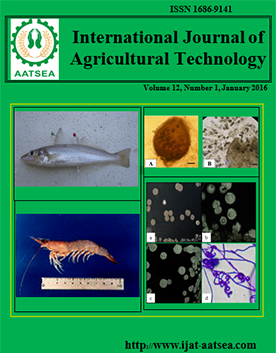Factors influencing self-reliance in rice production, the case of small farmers in Bataan, Philippines
Main Article Content
Abstract
Article Details

This work is licensed under a Creative Commons Attribution-NonCommercial-NoDerivatives 4.0 International License.
References
Abas, M. (2013). Appropriate agricultural strategies for small farmers in bataan, philippines to enhance self-reliance. The Journal of Interdisciplinary Networks 2:203-212.
Alam, M., Siwor, C., Talib, B. and Toriman, M. (2011). The relationship between the socio-economic profile of farmers and paddy productivity in north west selangor, Malaysia. Asia Pacific Development Journal 1:54-61.
BAO (2012). Rice production in Bataan Province. In Appropriate Agricultural Strategies for Small Farmers in Bataan, Philippines to Enhance Self-Reliance. The Journal of Interdisciplinary Networks 2:203.
BAS (2012). Bureau of agricultural statistics, statistical database production of rice in Central Luzon. Available from www.bas.gov.ph. In appropriate agricultural strategies for small farmers in Bataan, Philippines to enhance self-reliance. The Journal of Interdisciplinary Networks 2:203.
Calderon, R. P. (2008). Continuing rice deficiency: pre-condition for food crisis in the Philippines. In self-reliant rice farming strategies in the face of climate change for small farmers in Bataan, Philippines. International Journal of Agricultural Technology 10:10-51.
Chaiumporn, S. (1987). Development of a self-reliance measuring instrument for farmers of northern Thailand. Research center. National Institute of Development Administration.
CPFE (1991). Food from Dryland Gardens - An ecological, nutritional, and social approach to small-scale household food production. Food and Nutrition Library. Retrieved from http:///www.nzdl.org.
Dillon, J. L. (1992). The farm as a purposeful system. Miscellaneous Publication No. 10. Department of Agricultural and Resource Economics, University of New England, Armidale.
FAO (2001). Crop diversification in the Asia-pacific region. FAO FIAT PANIS, RAP Publication.
Gache, P. H. T. (2010). Socio-economic determinants of the choice of marketing arrangement of rice farmers in Bataan. Thesis Manuscript, UP Los Baños, Philippines.
Harmsupothi, S. (2003). A study of potential in self-reliance development at the village level.Khon Kaen. Ph.D. Thesis, Khon Kaen University.
Kast, E. F. and Rosenzweig, J. E. (1979). Organization and management.: A systems and contingency approach. Mcgraw-HillBook Company, Philippines.
Komthong, C. (2003). Natural resources managementfor sustainable production of community. M.S. Thesis, Chiang Mai University.
Kundaji, D. (2009). Farmers as seed breeders and custodians. Third World Resurgence 230: 78-91.
OECD (1999). Environmental data compendium. OECD, Paris. 276 pp.
Ojehomon, V. E. T., Adebayo, S. B., Ogundele, O. O., Okoruwa, V. O., Ajayi, O., Diagne, A. and OgunlanaI, O. (2009). Building a rice data systems in Nigeria: national rice survey. Rice Data Systems in Nigeria. Retrieved from http://www.nigerianstat.gov.ng.
Oktarina, S., Hakim, N. and Junaidi, Y. (2012). The level of farmer selfreliance and institutional strengthness strategy in empowerment of lowland rice in ogan ilir regency south sumatera Indonesia. International Proceedings of Chemical, Biological and Environmental Engineering 33: 42-51.
Philrice (2009). Sources of production growth. The Philippine Rice Master Plan 2009-2013. 120 pp.
Pretty, J. (1995). Regenerating agriculture. policies and practice for sustainability and self-reliance. Earthscan, London.
Rerkrai, D. (1984). Community development. Institute of Extension and Training, Kasetsart University, Bangkok.
Thaiembassy (2009). Philosophy of Sufficiency Economy. Retrieved from www.thaiembassy.com.
UNDP (2010). Rice cultivation in Thailand. In Sustainable Rice Production System: Scoping Paper. Green Commodity facility 12: 7-8.
UN ESCAP (2006). The New Theory. Green Growth at a Glance: The Way Forward for Asia and Pacific.
UNEP-UNCTAD (2008). Organic Agriculture and Food Security. UN Program. New York and Geneva.


